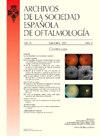2018 - 2023年远程医疗筛查项目中糖尿病视网膜病变患病率分析
Q3 Medicine
Archivos De La Sociedad Espanola De Oftalmologia
Pub Date : 2025-07-01
DOI:10.1016/j.oftal.2025.02.008
引用次数: 0
摘要
背景与目的糖尿病视网膜病变(DR)是糖尿病最常见的眼部并发症。使用眼底检查和视网膜成像的筛查方案是早期诊断DR和改善疾病预后的有用工具。本研究的目的是分析Castilla y León卫生系统中参加DR筛查计划的患者人数,并估计DR的患病率和严重程度。材料和方法对2018年至2028年间参加筛查计划的既往登记为糖尿病患者进行了一项观察性研究。根据诊断结果分为不可评价试验、不可评价患者、无DR、DR(轻度、中度、重度、增殖性及疑似糖尿病性黄斑水肿)及其他病理。结果截至目前,该方案的总咨询次数为31901次,从2018年的3934次增加到2023年的9508次。DR的估计患病率为15.41%。1.58%的患者因DR或其他病理需要紧急治疗而转诊到参考医院。其余患者由该项目管理。结论:DR的患病率似乎略低于其他已发表的系列报道,但在不同的项目年限、总体评估、不同形式的DR或疑似糖尿病性黄斑水肿之间没有观察到显著差异。本文章由计算机程序翻译,如有差异,请以英文原文为准。
Análisis de la prevalencia de la retinopatía diabética en un programa de cribado por telemedicina durante el periodo 2018 a 2023
Background and objectives
Diabetic retinopathy (DR) is the most common ocular complication of diabetes. Screening programmes using fundus examination with retinal imaging are a useful tool for early diagnosis of DR and an improved disease prognosis. The purpose of this study is to analyse the number of patients attended in the DR screening programme of the Castilla y León health system and to estimate DR prevalence and severity.
Material and methods
An observational study of patients previously registered as diabetic who participated in the screening programme between 2018 and 2028 was conducted. Patients were classified according to their diagnosis in non-evaluable test, non-evaluable patient, no DR, DR (mild, moderate, severe, proliferative, and suspected diabetic macular oedema) and other pathologies.
Results
The total number of consultations in the program up to the present date has been 31,901, increasing from 3,934 in 2018 to 9,508 in 2023. The estimated prevalence of DR is 15.41%. 1.58% of patients were referred to their reference hospitals due to DR or other pathologies requiring urgent treatment. The remaining patients were managed by the program.
Conclusions
The prevalence of DR appears to be slightly lower than that reported in other published series, but no significant differences were observed between different program years, overall assessment, or different forms of DR or suspected diabetic macular oedema.
求助全文
通过发布文献求助,成功后即可免费获取论文全文。
去求助
来源期刊

Archivos De La Sociedad Espanola De Oftalmologia
Medicine-Ophthalmology
CiteScore
1.20
自引率
0.00%
发文量
109
审稿时长
78 days
期刊介绍:
La revista Archivos de la Sociedad Española de Oftalmología, editada mensualmente por la propia Sociedad, tiene como objetivo publicar trabajos de investigación básica y clínica como artículos originales; casos clínicos, innovaciones técnicas y correlaciones clinicopatológicas en forma de comunicaciones cortas; editoriales; revisiones; cartas al editor; comentarios de libros; información de eventos; noticias personales y anuncios comerciales, así como trabajos de temas históricos y motivos inconográficos relacionados con la Oftalmología. El título abreviado es Arch Soc Esp Oftalmol, y debe ser utilizado en bibliografías, notas a pie de página y referencias bibliográficas.
 求助内容:
求助内容: 应助结果提醒方式:
应助结果提醒方式:


